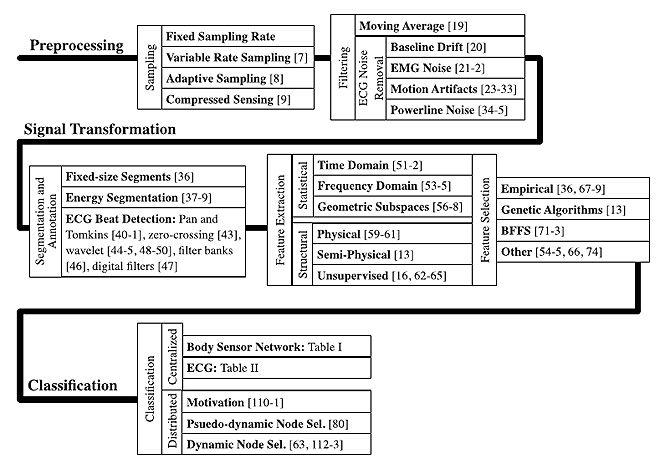Wireless Medical-Embedded Systems: A Review of Signal-Processing Techniques for Classification
By Hassan Ghasemzadeh, Sarah Ostadabbas, Eric Guenterberg, and Alexandros Pantelopoulos
NOTE: This is an overview of the entire article, which appeared in the February 2013 issue of the IEEE Sensors Journal.
Click here to read the entire article.
Abstract
Body-worn sensor systems will help to revolutionize the medical field by providing a source of continuously collected patient data. This data can be used to develop and track plans for improving health (more sleep and exercise), detect disease early, and provide an alert for dangerous events (e.g., falls and heart attacks). The amount of data collected by even a small set of sensors running all day is too much for any person to analyze. Signal processing and classification can be used to automatically extract useful information. This paper presents a general classification framework for wireless medical devices and reviews the available literature for signal processing and classification systems or components used in body-worn sensor systems. Examples focus on electrocardiography classification and signal processing for inertial sensors.
The authors point out that classification here refers to the process of summarizing the data, highlighting relevant sections, and generating alerts in response to certain observed events. The paper focuses particularly on examples from electrocardiography (ECG signals) and inertial sensor systems. The approach should also be applicable to other systems, however.
Classification is presented in four stages; Preprocessing, Signal Transformation, Centralized Data Processing and Distributed Data Processing (as illustrated in Figure 1)

Generic signal processing flow for classification applications.
Preprocessing includes decisions about how and when to sample sensor data and noise filtering. Preprocessing is about transforming the signal in bulk without separating out events or classifying the data.
Signal transformation changes the data into a form more useful for classification. First, the signal is divided into segments, then a multi-dimensional feature vector is extracted from each segment.
Centralized Data Processing systems use algorithms for local processing of the data and using a data fusion scheme at a base station for summarizing state of the system. In contrast, in a Distributed Data Processing system, each node makes a local decision on the target action and may decide to propagate its local results to a next node.
The authors describe these stages and give numerous examples of the choices available within each. In conclusion, they present some challenges that exist in the area of embedded wireless medical systems. An extensive set of references to the literature accompanies the paper.
ABOUT THE AUTHORS
NOTE: A more complete bio of the authors is available in the article.
Hassan Ghasemzadeh (hassan@cs.ucla.edu) is with the Computer Science Department, University of California, Los Angeles, CA 90095 USA.
Sarah Ostadabbas (sarahostad@utdallas.edu) and Eric Guenterberg (mavpion@gmail.com) are with the Electrical Engineering Department, University of Texas at Dallas, Richardson, TX 75080 USA.
Alexandros Pantelopoulos (alekospant@gmail.com) is with West Wireless Health Institute, La Jolla, CA 92037 USA.






